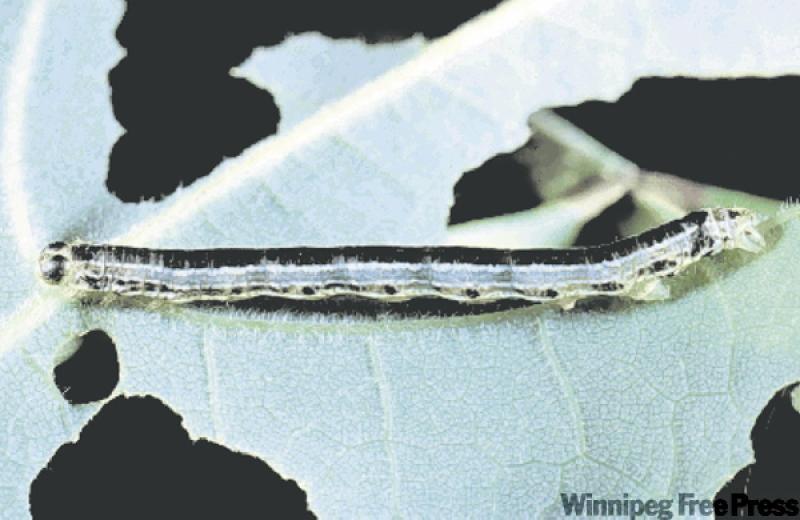Over the last couple of weeks, cankerworms have been devouring the leaves of trees in southern Manitoba. Many varieties of trees are affected: elm (especially), ash, maple, oak, basswood, linden, Schubert choke cherry and fruit trees,
There are two types of cankerworms -- fall and spring. The naming of the cankerworm is based on the season in which it lays eggs. Both kinds look identical to the lay person and both cause damage in the spring when the eggs hatch and the leaves come out.
The fall female cankerworm adult, which is a moth, lays its eggs on trees before winter. It usually does this after the first severe autumn frost. The female, unlike most moths, can not fly so she must crawl up the tree to find her mate and produce eggs. The eggs hatch into cankerworm larvae in the spring.
The spring cankerworm female adult, also a moth, climbs up the tree in the early spring to mate. It lays its eggs after the first significant spring thaw, usually in April.
There was a very large hatch of spring cankerworms this year in a number of areas of the city, and these have been the cause of most of the damage I have seen.
Cankerworms are caterpillars that crawl with a looping gait because of their small number of fleshy legs on the abdomen -- five pairs instead of six on the typical caterpillar. The spring cankerworm has two pairs of prolegs (or front legs) while the fall cankerworm has three pairs of prolegs.
Putting up Tanglefoot sticky bands on the trees in fall (Labour Day period) helps to trap the fall and spring cankerworms. However, if the bands are not very sticky in April, or if there is too much debris on them, the spring cankerworm moth will simply crawl over those essentially useless bands and get up into the trees to lay her eggs. It's very important that the bands are checked for stickiness in the spring, and it's a good idea to reapply Tanglefoot in any case.
If bands are not used, or if the cankerworms were not trapped by them, the fall-back option is to have the biological pesticide, Btk, sprayed on the trees. Its not a contact pesticide like Malathion but must be eaten with the leaves to kill the worms. Normally, licensed pest-applicator companies are contracted for this spraying, but be sure you get quotes for doing this work as it can vary quite a bit from company to company.
Here is a question I get all the time: "I put up Tanglefoot bands on all of my trees, but I still got heavy feeding by worms on the leaves. Is Tanglefoot no longer useful? What is going on?"
Several things could be happening here.
First, were your bands sufficiently sticky to trap the flightless spring female cankerworm moths? Most bands I saw in the late March to April period this year were dry. It is absolutely important to check the bands after winter for stickiness and reapply Tanglefoot if necessary.
Second, if the tops of your trees are in contact or very close to the tops of neighbouring unbanded trees, the female moths and newly hatched cankerworms can easily walk over from your neighbour's trees to lay eggs in yours. So all the work you did to put up the bands becomes a waste of time. Neighbours should talk about their trees and co-ordinate a local community banding program.
Lastly, it's possible your problem isn't cankerworms at all. The elm span worm does similar feeding damage, is a bit larger than the cankerworm and is usually a mottled grey-brown in colour. Both the female and male moths fly, so they would not be trapped by Tanglefoot bands. The moths are pure white and have a wing span of about 2.5 to 3 cm (1 to 1- º inches) wide. Span worms, like cankerworms, can be controlled with Btk in early spring.
The best method to control cankerworms is still Tanglefoot bands. They need to be very sticky and relatively free of insects and leaf litter in the September-October and in April-May periods.
Michael Allen is a consulting urban forester, certified I.S.A. arborist and owner of Viburnum Tree Experts. He makes house and garden visits to assess tree and shrub problems. He can be contacted by calling 831-6503 or by email at viburnumtrees@shaw.ca You can also mail questions to Michael Allen, c/o Newsroom, Winnipeg Free Press, 1355 Mountain Ave., Winnipeg, MB, R2X 3B6. His website is www.treeexperts.mb.ca




